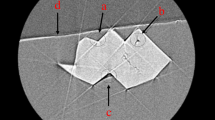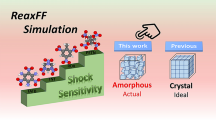Abstract
Context
Under the ReaxFF/lg force field, the multiscale shock technique (MSST) was employed to investigate the decomposition behavior of perfect, dislocated, and twinned octahydro-1,3,5,7-tetranitro-1,3,5,7-tetrazocine (HMX) at a velocity of 11 km/s. This study aimed to analyze the changes in system temperature, bond formation and breaking, variations in the number of small molecules, and the number of clusters. The results indicated that the sensitivity of dislocated HMX was the lowest, while the sensitivity of twinned and perfect HMX was comparable. Comparing the formation and breaking of bonds in HMX during the shock process, it was found that the change in the number of bonds in dislocated HMX was similar to that in perfect HMX, whereas twinning accelerated the breaking of bonds. By analyzing the changes in small molecular fragments (CO, CO2, H, H2, H2O, N2, N2H, NH2, NO, NO2, and O) during the shock process of HMX, it was found that dislocation had a relatively minor effect on the small molecular fragments, while twinning promoted the generation of CO, H, NO, and O and accelerated the decomposition of NO. A comparison of the number, weight, and atomic ratio of clusters under perfect, dislocated, and twinned conditions revealed that under the influence of shock, the number of clusters initially increased sharply and then decreased slowly. Meanwhile, compared to the perfect and dislocated explosives, the number of clusters under the twinned structure was significantly fewer, indicating that the twinned structure could reduce cluster formation. The proportion of oxygen to carbon in the twinned HMX was lower than that in the perfect and dislocated explosives, possibly due to the higher content of small molecular fragment O in twinned HMX.
Methods
Different structures of HMX crystals were constructed, including twinned defect structure (with a supercell containing 6458 atoms), dislocation defect structure (with a supercell containing 2352 atoms), and perfect structure (also with a supercell containing 2352 atoms). The modeling of defect crystal structures was carried out using the Atomsk software. For the twinned defect structure, we first constructed a mirror symmetric structure of the original configuration and then merged these two structures together. For the dislocation defect structure, we shifted a segment of the originally ordered perfect crystal structure by a certain distance using Atomsk. Before conducting the simulations, we performed geometric optimization of the models using the conjugate gradient (CG) algorithm and carried out 10 ps of NVT and NPT simulations to equilibrate the energy, temperature, and other parameters within the system. Finally, a 50-ps MSST impact simulation was performed using Large-scale Atomic/Molecular Massively Parallel Simulator (LAMMPS).








Similar content being viewed by others
Data availability
No datasets were generated or analyzed during the current study.
References
Mao JS, Wang BG, Zhu R, Chen YF, Fu JB (2023) Investigation of the decomposition mechanism of MTNP melt-cast explosive at different temperatures and pressures through ReaxFF/lg molecular dynamics simulations. J Mol Model 29:354
Jiang J, Wang HR, Zhao FQ, Xu SY, Ju XH (2023) Decomposition mechanism of 1, 3, 5-trinitro-2, 4, 6-trinitroaminobenzene under thermal and shock stimuli using ReaxFF molecular dynamics simulations. Phys Chem Chem Phys 25:3799–3805
Kou Y, Luo P, Xiao L, Xin Y, Zhang G, Hu Y, Hao G (2023) New insights in nano-copper chromite catalyzing ultrafine AP: evaluation of dispersity and mixing uniformity. Defence Technology. https://doi.org/10.1016/j.dt.2023.04.004
Wu J, Huang Y, Yang L, Geng D, Wang F, Wang H, Chen L (2018) Reactive molecular dynamics simulations of the thermal decomposition mechanism of 1, 3, 3-trinitroazetidine. ChemPhysChem 19:2683–2695
Castro-Marcano F, Kamat AM, Russo Jr MF, van Duin AC, Mathews JP (2012) Combustion of an Illinois No. 6 coal char simulated using an atomistic char representation and the ReaxFF reactive force field. Combust Flame 159:1272–1285
Liu L, Bai C, Sun H, Goddard III WA (2011) Mechanism and kinetics for the initial steps of pyrolysis and combustion of 1, 6-dicyclopropane-2, 4-hexyne from ReaxFF reactive dynamics. J Phys Chem A 115:4941–4950
Ma X, Zhu W, Xiao J, Xiao H (2008) Molecular dynamics study of the structure and performance of simple and double bases propellants. J Hazard Mater 156:201–207
Sakano MN, Hamed A, Kober EM, Grilli N, Hamilton BW, Islam MM, Strachan A (2020) Unsupervised learning-based multiscale model of thermochemistry in 1, 3, 5-trinitro-1, 3, 5-triazinane (RDX). J Phys Chem A 124:9141–9155
Reed EJ, Fried LE, Joannopoulos JD (2003) A method for tractable dynamical studies of single and double shock compression. Phys Rev Lett 90:235503
Reed EJ (2012) Electron-ion coupling in shocked energetic materials. J Phys Chem C 116:2205–2211
Wen Y, Dai X, Han Y, Xiang Y (2014) Reaction characteristic for various scale explosive under mild impact. J Energ Mater 32:S41–S50
Liu H, He Y, Li J, Zhou Z, Ma Z, Liu S, Dong X (2019) ReaxFF molecular dynamics simulations of shock induced reaction initiation in TNT. AIP Adv 9(1)
Yuan JN, Wei YK, Zhang XQ, Chen XR, Ji GF, Kotni MK, Wei DQ (2017) Shock response of 1, 3, 5-trinitroperhydro-1, 3, 5-triazine (RDX): the CN bond scission studied by molecular dynamics simulations. J Appl Phys 122(13)
Ge NN, Bai S, Chang J, Ji GF (2018) Shock response of condensed-phase RDX: molecular dynamics simulations in conjunction with the MSST method. RSC Adv 8:17312–17320
Zheng-Hua H, Jun C, Guang-Fu J, Li-Min L, Wen-Jun Z, Qiang W (2015) Dynamic responses and initial decomposition under shock loading: a DFTB calculation combined with MSST method for β-HMX with molecular vacancy. J Phys Chem B 119:10673–10681
Li H, Li A, Dou Y (2018) Molecular dynamics simulation of primary detonation process of TATB crystal under shock loading. Mol Simulat 44:1176–1182
Wang F, Chen L, Geng D, Lu J, Wu J (2020) Chemical reactions of a CL-20 crystal under heat and shock determined by ReaxFF reactive molecular dynamics simulations. Phys Chem Chem Phys 22:23323–23332
Zhao P, Lee S, Sewell T, Udaykumar HS (2020) Tandem molecular dynamics and continuum studies of shock-induced pore collapse in TATB. Propell Explos Pyrot 45:196–222
Islam MM, Strachan A (2019) Reactive molecular dynamics simulations to investigate the shock response of liquid nitromethane. J Phys Chem C 123:2613–2626
Field JE (1992) Hot spot ignition mechanisms for explosives. Acc Chem Res 25:489–496
Thompson AP, Aktulga HM, Berger R, Bolintineanu DS, Brown WM, Crozier PS, Plimpton SJ (2022) LAMMPS-a flexible simulation tool for particle-based materials modeling at the atomic, meso, and continuum scales. Comput Phys Communications 271:108171
Liu L, Liu Y, Zybin SV, Sun H, Goddard III WA (2011) ReaxFF-lg: correction of the ReaxFF reactive force field for London dispersion, with applications to the equations of state for energetic materials. J Phys Chem A 115:11016–11022
Van Duin AC, Dasgupta S, Lorant F, Goddard WA (2001) ReaxFF: a reactive force field for hydrocarbons. J Phys Chem A 105:9396–9409
Wang QD, Wang JB, Li JQ, Tan NX, Li XY (2011) Reactive molecular dynamics simulation and chemical kinetic modeling of pyrolysis and combustion of n-dodecane. Combust Flame 158:217–226
Mueller JE, Van Duin AC, Goddard III WA (2010) Application of the ReaxFF reactive force field to reactive dynamics of hydrocarbon chemisorption and decomposition. J Phys Chem C 114:5675–5685
Zhou T, Zybin SV, Liu Y, Huang F, Goddard WA (2012) Anisotropic shock sensitivity for β-octahydro-1, 3, 5, 7-tetranitro-1, 3, 5, 7-tetrazocine energetic material under compressive-shear loading from ReaxFF-lg reactive dynamics simulations. J Appl Phys 111(12)
Huang X, Qiao Z, Dai X, Zhang K, Li M, Pei G, Wen Y (2019) Effects of different types of defects on ignition mechanisms in shocked β-cyclotetramethylene tetranitramine crystals: a molecular dynamics study based on ReaxFF-lg force field. J Appl Phys 125(19)
Hirel P (2015) Atomsk: a tool for manipulating and converting atomic data files. Comput Phys Commun 197:212–219
Funding
No funds, grants, or other support was received.
Author information
Authors and Affiliations
Contributions
Can-shu Yang: determined the main frame of the article and researched and compiled the thesis
Shu-hai Zhang: investigated and provided the article’s conception and feasibility analysis
Corresponding author
Ethics declarations
Ethics approval
This article does not present research with ethical considerations.
Conflict of interest
The authors declare no competing interests.
Additional information
Publisher’s Note
Springer Nature remains neutral with regard to jurisdictional claims in published maps and institutional affiliations.
Rights and permissions
Springer Nature or its licensor (e.g. a society or other partner) holds exclusive rights to this article under a publishing agreement with the author(s) or other rightsholder(s); author self-archiving of the accepted manuscript version of this article is solely governed by the terms of such publishing agreement and applicable law.
About this article
Cite this article
Yang, Cs., Zhang, Sh. Investigation of dislocation and twinning behavior in HMX under high-velocity impact employing molecular dynamics simulations. J Mol Model 30, 50 (2024). https://doi.org/10.1007/s00894-024-05851-1
Received:
Accepted:
Published:
DOI: https://doi.org/10.1007/s00894-024-05851-1




